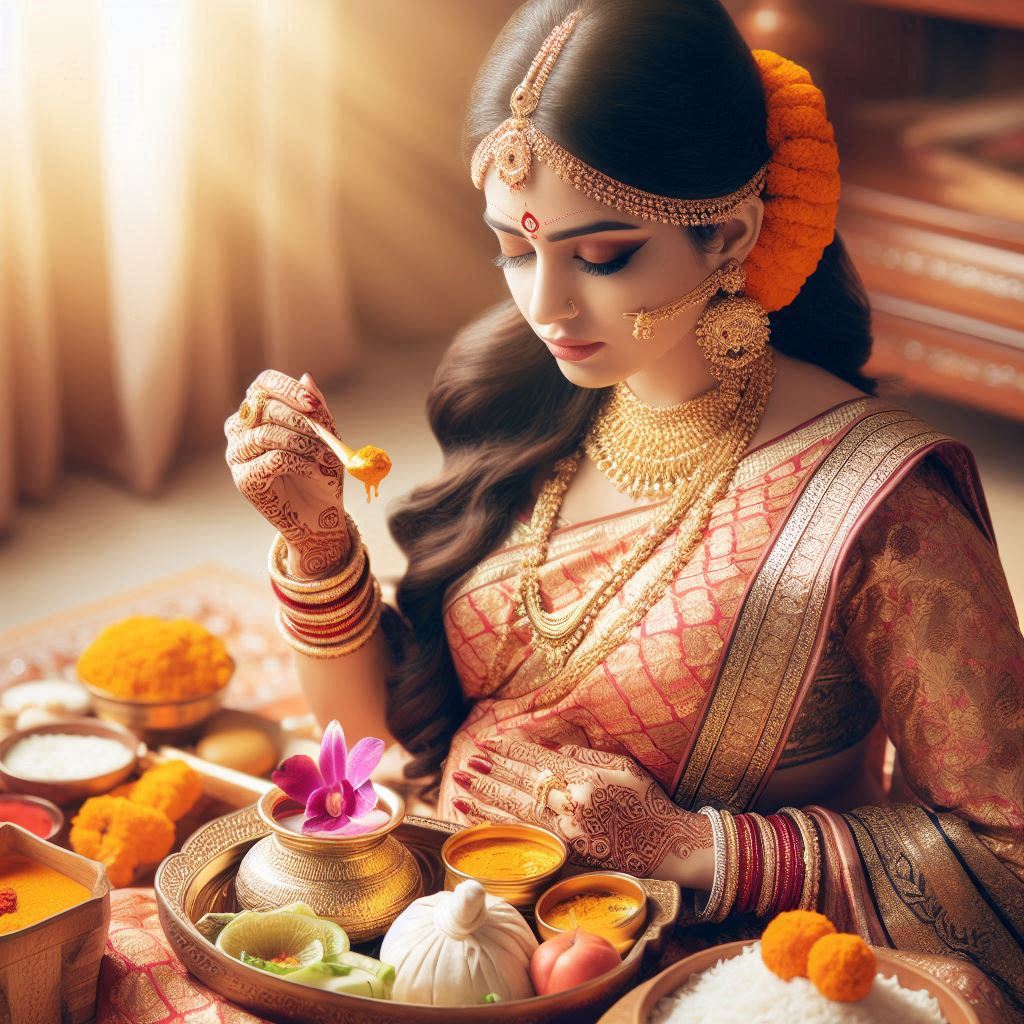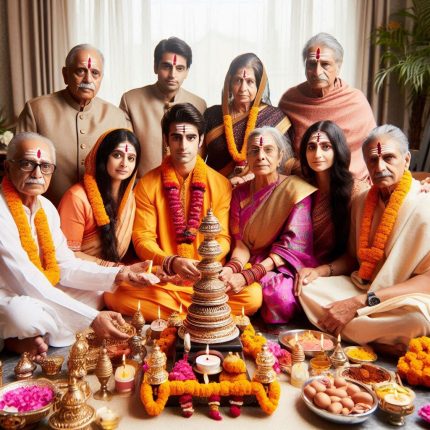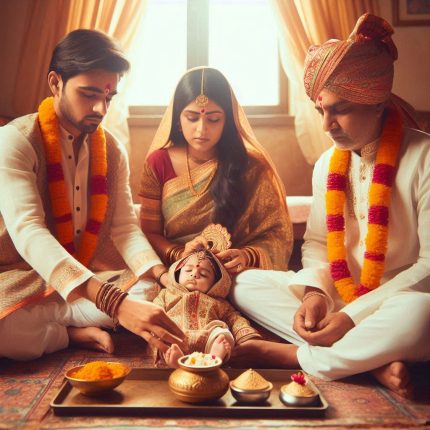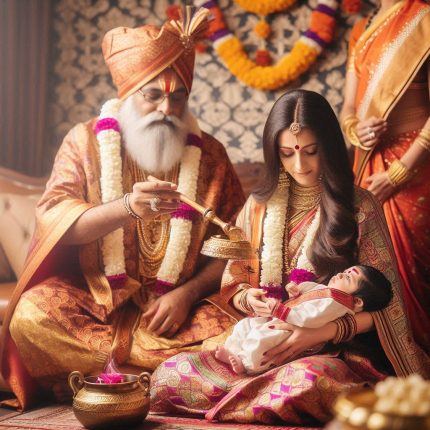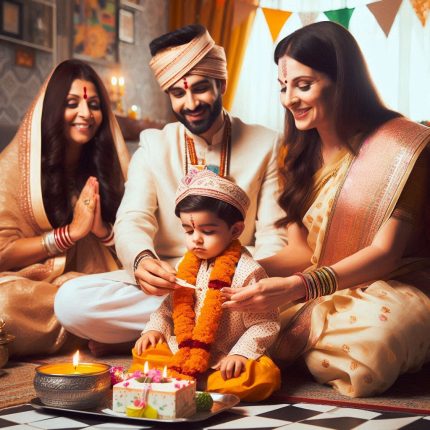Godh Bharai Puja: Celebrating the Expectant Mother
Samagri
for Puja:
Haldi [organic] (20gm), Kumkum [organic] (20gm), Tulsi Mala (1), Diya Batti (5), Beetle Nuts (5), Desi Ghee (20ml), Honey (20ml), Jaggery (Gudh) (20gm), Akshata [Yellow rice] (20gm), Yagno-paveetha (5), Karpoora [camphor] (5Tabs), Red/White/Yellow Cloth(1 mtr), Prasad [Laung, Elaichi, Mishri] (20gm), Mouli (25mtr), Ganga Jal (15ml), Durva [fresh] (1), Agarbatti (6)/Dhoop (2), Dakshina (100INR), God Idols (pair), Sambrani (2), Sambrani Holder (1), Kalash [small copper] (1), Panchpatra [small copper] (1), Diya Holder (2), Panchamrit spoon (1), Karpoora Holder(1), includes perishables [Beetle Leaves [fresh] (9), Flowers [fresh] (incl mala), Tulsi [fresh], Mango Leaves [fresh] (7)]
Small Havan:
Cow Dung Cake (2), Mango Wood (250gm), HavanSamagri [20+ Grganic Herbs] (100gm), Ghee (20ml)
Yajman to provide:
Curd (100gm), Milk (100ml), Mithai (250gm), Fruits [5types], Coconut (1), HavanKund, SuchiSarva (Havan Spoon) (1), Kalash [big] (1), Bowl [preferably copper/silver] (1), Spoon [preferably copper/silver] (1), Utensils [2 big Plates (for Aarti/Samagri), disposable Plates, Bowls & Spoons], First solid food (preferably Kheer or Payasam)
Introduction
The Godh Bharai Puja, also known as the “Baby Shower” or “Godh Bharai Ceremony,” is a cherished pre-natal ritual celebrated in various cultures. This auspicious ceremony is held to honour and celebrate a pregnant woman, acknowledging the joy and significance of impending motherhood. The Godh Bharai Puja is a time for family and friends to come together to bless the expectant mother, pray for the health of the baby, and prepare for the new arrival with joy and reverence.
Importance and Significance of Godh Bharai Puja
The Godh Bharai Puja holds deep cultural and spiritual significance:
- Celebration of Motherhood: The puja celebrates the journey of motherhood and the imminent arrival of a new life. It honours the expectant mother’s role and provides her with emotional and spiritual support.
- Divine Blessings: The ceremony seeks blessings from deities for the health and well-being of both the mother and the baby. It is a time to invoke divine protection and ensure a safe delivery.
- Family Bonding: The puja brings family and friends together, reinforcing familial bonds and creating a supportive environment for the expectant mother.
- Cultural Tradition: The ritual upholds cultural values and traditions, allowing families to connect with their heritage and pass down important customs.
Benefits of Godh Bharai Puja
Participating in the Godh Bharai Puja offers numerous benefits:
- Emotional Support: The ceremony provides emotional comfort and support to the expectant mother, celebrating her journey and preparing her for the upcoming changes.
- Health and Well-being: The puja seeks divine blessings for the health of both mother and baby, aiming to ensure a smooth pregnancy and safe delivery.
- Community Support: The gathering of family and friends creates a sense of community and support, making the expectant mother feel cherished and valued.
- Cultural Enrichment: Engaging in traditional practices enriches the cultural experience and strengthens family traditions.
Occasions to Perform Godh Bharai Puja
The Godh Bharai Puja is typically performed during the later stages of pregnancy, though the timing can vary based on cultural practices and personal preferences:
- Second Trimester: The puja is often held in the second trimester, when the pregnancy is considered stable, and it is a time to celebrate the upcoming arrival.
- Personal Preferences: The exact timing of the ceremony can be chosen based on family traditions, availability of loved ones, and the expectant mother’s comfort.
Godh Bharai Puja Vidhi (Procedure)
The Godh Bharai Puja involves several traditional and ceremonial steps, each contributing to the ritual’s significance:
- Preparation: The expectant mother dresses in traditional attire, often in vibrant colours. The ceremony venue is decorated with flowers, lights, and auspicious symbols. Special items such as sweets, fruits, and gifts are prepared for the occasion.
- Welcome and Rituals: Family and friends gather to welcome the expectant mother and participate in the puja. The ceremony may include lighting a lamp (diya) and offering prayers to seek blessings for a healthy delivery.
- Application of Haldi: Similar to the Haldi Ceremony, a mixture of turmeric, sandalwood, and other auspicious ingredients may be applied to the expectant mother’s body as a symbol of purity and protection.
- Aarti and Offerings: Aarti is performed to seek divine blessings, and offerings such as sweets, fruits, and gifts are presented to the expectant mother. Traditional songs and prayers may be recited to celebrate the occasion.
- Gifts and Blessings: Guests present gifts to the expectant mother, including items for the baby and practical gifts for the mother. Elders offer their blessings and good wishes for a safe and healthy delivery.
- Celebration: The ceremony is followed by a celebratory meal, allowing family and friends to socialize, share joy, and express their love and support for the expectant mother.
Godh Bharai Puja Shubh Muhurat
While the Shubh Muhurat (auspicious time) for the Godh Bharai Puja is less strictly defined compared to other ceremonies, it is often planned during a favourable time based on personal preferences and astrological recommendations. Consulting with a family astrologer can help determine an ideal time for the ceremony.
Conclusion
The Godh Bharai Puja is a heart-warming and significant ritual that celebrates the expectant mother and the joyous anticipation of a new life. By participating in this cherished tradition, families honour the journey of motherhood, seek divine blessings for health and happiness, and create a supportive and loving environment for the arrival of the new baby. It is a beautiful way to connect with cultural traditions, celebrate family, and prepare for the joyous changes ahead.

